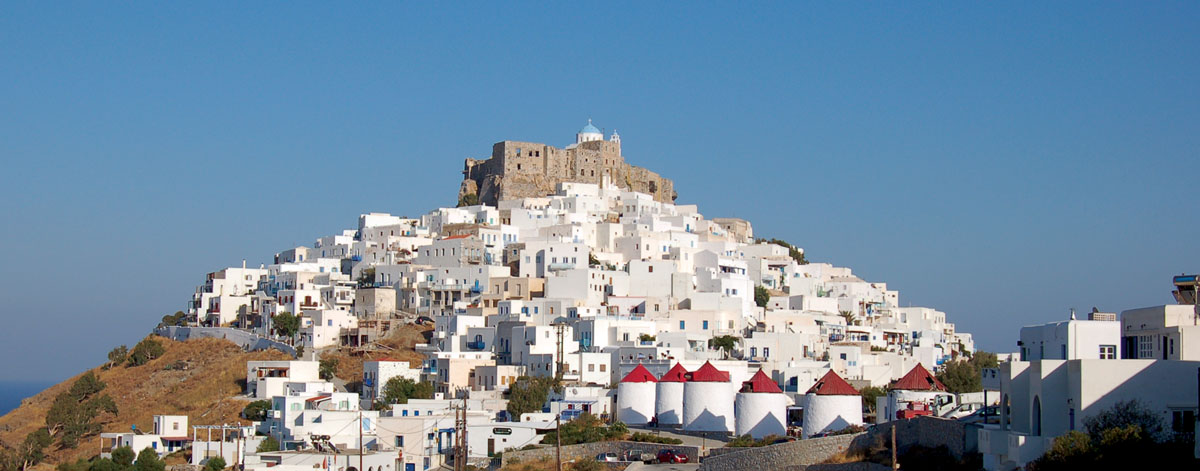
View of Chora, Astypalaia
Astropaliá or Astipaliá as known by the locals. One of the first names given to the island was ICTHYÓESSA. Other ancient names are Astipalaía, Astipáleia and Astipalía. During the Venetian rule the island was known as “Stabália”. According to some, the name “Astipálaia” comes from the words “ásti-palaiós” (ancient town), as the Dorians discovered an old town when they installed themselves on the island.
The island knew great wealth during antiquity, especially from shipping. Its prosperity continued during the Roman rule, when it was a commercial station but also a pirate hideout. Its ancient acme is professed not only by the sanctuaries of Athená and of Asklipiós, but an abundance of other findings. After the Persian wars (5th century BC) the island became a member of the Athenian Allies. The ancient cynical philosopher and historian Onisíkritos, student of Diogénis, came from the island (the cynical believe that man should define his needs and that he should be independent not only of his environment but also of himself). Onisíkritos was a very daring and extremely able seafarer, admired by Alexander the Great who made him commander of the helmsmen in his fleet.
The famous boxer Kleomídis was also from the island, who in the 71st Olympics (496 BC) killed his opponent, Íkkos from Epídavros, with just one blow. The judges did not appoint him as Olympic Champion “due to offence” and he went insane from his grief. When he returned to the island, he entered the school during lesson time and pushed the column supporting the roof with such a force that the roof fell in, killing all the students as a result. The inhabitants chased and stoned him and Kleomídis ran for shelter to the temple of Athená, closing himself inside a box and held the lid down with such might that the inhabitants were unable to open the box. Finally it was decided to smash the cover, but the box was empty. Then the inhabitants went to consult the Oracle at Delphí, who told them that Kleomídis was no longer mortal and that they should honour him with sacrifices.
Another event of this age was the island’s plague of large flocks of hares. There were so many that it is said that one day the inhabitants killed 6000 hares. They again consulted the Oracle at Delphí, and were told to breed dogs from Lakonía. Even today the island is rich with hare hunters.
During the Byzantine period the castle of Ágios Ioánnis (9th century) was built on the west part of the island. In 1207, the island was captured by the Venetian Marco Sanudo (Aegean Duchy) who then made it over to his comrade-in-arms, the Venetian John Quirini (a descendant of his, Nicholas Quirini, built the Quirini-Stampalia Mansion in Venice). The Frankish dynasties held the island for almost 3.5 centuries, except for a break of 60 years in which the island had been freed by the Byzantine forces. In 1413 the family of Quirini built the castle which now stands out in the island’s capital and they walled their family coat-of-arms in the church of the castle. In 1537 the island was plundered by the Turkish Admiral Barbarossa, and the Venetians finally handed it over to them in 1540. The island remained under the Turkish yoke until 1912, when the island was captured by the Italians and finally joined Mother Greece after the culmination of the 2nd World War in 1948.
Astipálaia is one of the two or three islands in the Mediterranean that does not have snakes (it was confirmed during antiquity by Aristotélis). This is due to the fact that it was the first migratory station of the storks from Africa, in Europe and Asia and vice versa.
Monastery of Agía Livíi: Dedicated to Panagiá Frevariótissa and built in a verdant basin with facilities to accommodate 20 people.
Monastery of Panagiá Poularianí: The patron saint of fishermen and of the sea in general. It has facilities to accommodate 30 people. It is built on elevated ground and the rock underneath resembles a woman holding a baby in her arms. This is the Virgin Mary, say the fishermen.
Local tastes the freshest fish (the ancient Greeks must have known something calling it Ichthyóessa, which means “fishy”) and do not forget to try the savoury “pougkiá” (small cheese pies with “kopanistí”, a type of white cheese) and the sweet “pougkiá” (small cheese pies with “chlorí”, a type of soft cheese, and honey).





